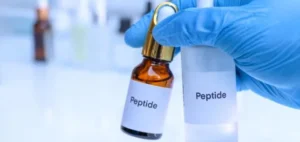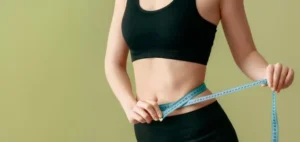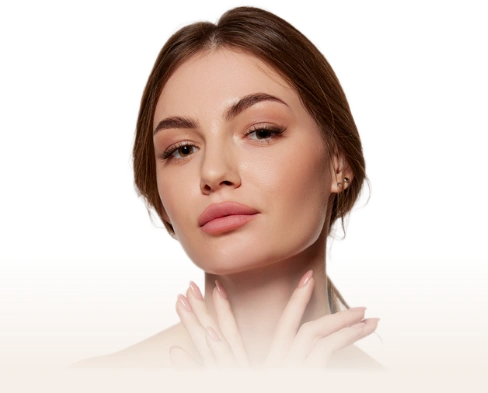Cheek fillers increase cheek volume and define your cheekbones. Healthcare providers inject fillers into and around your cheeks. The procedure can take anywhere from 15 minutes to two hours. You often see results immediately and recover quickly, though, for some people, some side effects may occur.
Additionally, for those looking to enhance their facial features further, exploring lip flip options in NYC could provide a subtle yet effective way to enhance lip appearance without surgery.
What Is A Cheek Dermal Filler Injections?
Cheek filler is a non-surgical cosmetic procedure that gives your cheeks a fuller, more defined look. A healthcare provider injects safe substances called dermal fillers around and above your cheekbones.
Healthcare providers offer many kinds of cheek fillers. Your provider will discuss the best options for you based on your treatment goals.
Cheek fillers usually take less than half an hour to be administered. Botox or filler treatment can help the damaged blood vessels and capillaries recover faster. Depending on the type of filler you are using, the results can last as long as a year or even more. In comparison with other cosmetic procedures, cheek filler injections also bring a few risks with a wide range of benefits, including bleeding and bruising.
What Are The Benefits of Having a Cheek Filler Injections?
Cheek fillers offer several benefits, including:
- Enhanced cheek volume and contour
- Reduced appearance of fine lines and wrinkles
- Improved facial symmetry and balance
- Non-surgical and quick procedure with minimal downtime
What Are The Risks and Side Effects of Having a Cheek Filler?
While cheek fillers are generally safe, they come with potential risks and side effects, such as:
- Bruising and swelling at the injection site
- Redness and tenderness
- Allergic reactions or infection
- Lumps or unevenness in the treated area
What Causes Bruising After Cheek Fillers?
Bruising occurs when blood vessels are punctured by the needle that is used to inject the filler under the skin. Of course, bruising and bleeding should always be expected to a certain extent when getting any type of injectable treatment, be it medical or cosmetic. The reason that lips and tear troughs are so susceptible to bruising is that they are quite vascular, so the veins are harder to avoid.
However, bruising from filler injections is no different from any other type of bruises, such as those from blood tests or immunizations. As with any other, the kind of bruise you get from fillers will usually subside within 5-7 days.
Inherent in any kind of injection is the risk of bruising or swelling – this comes with the territory of putting a sharp needle into the skin. To reduce the chance of bruising, and to contain the bruise, aestheticians at times choose to use a needle called a ‘cannula.’ This is a long, blunt-tipped needle, which is used to create a single entry point at each side of the face. This means that only one injection site is needed, and the bruising may therefore be contained in just one specific area. Additionally, if you’re wondering about how long does Kybella swelling lasts, it typically varies from person to person, with most experiencing swelling for up to two weeks post-treatment.
How To Prevent Bruising After Cheek Fillers?
Each aesthetician will recommend doing different things to either prevent or reduce bruising. We strongly recommend that patients should follow the recommendations of their aesthetician; you must always take the advice of your own injector. This is because each injector will use a slightly different approach and may even use different products. Their advice will be tailored and personalized to their own technique and product, so it is important to listen to them!
Avoid blood thinning medications
Refrain from taking aspirin, ibuprofen, and other blood-thinning medications or supplements for at least a week before the procedure.
Avoid alcohol and caffeine
These can increase the risk of bruising and should be avoided 24-48 hours before treatment.
Use arnica and bromelain
Natural supplements like arnica and bromelain can help reduce bruising and should be taken before and after the procedure.
Ice the area
Applying an ice pack to the cheeks before and after the treatment can minimize swelling and bruising.
Communicate with your provider
Inform your injector of any medications or supplements you’re taking and any previous history of bruising.
Do and Don’t After Getting Fillers
Dos | Don’ts |
Apply ice packs to reduce swelling | Engage in strenuous exercise |
Stay hydrated | Consume alcohol |
Sleep with your head elevated | Touch or massage the treated area |
Follow post-care instructions | Expose your skin to direct sunlight |
Use gentle skincare products | Avoid taking blood thinners |
How Long Does Bruising After Cheek Fillers Last?
Bruising under the eyes can occur if the filler migrates or if the injection affects the delicate blood vessels in this area. This bruising usually resolves on its own within a week but can be treated with the same methods used for cheek bruising.
How To Reduce Bruising After Cheek Fillers?
- Apply ice packs: Use cold compresses on the treated area immediately after the procedure.
- Take arnica supplements: Arnica can help speed up the healing process and reduce bruising.
- Elevate your head: Sleeping with your head elevated can reduce swelling and bruising.
- Avoid vigorous activities: Refrain from intense physical activities for at least 24-48 hours post-treatment.
- Use topical treatments: Arnica gel or creams specifically designed for bruising can be applied to the affected area.
How To Calm Post-Treatment Bruising?
To avoid bruising, apply cold compresses regularly and avoid any activities that could exacerbate the bruising. Keeping the treated area clean and following your provider’s post-care instructions will also help.
What Does Normal Bruising Look Like After Filler?
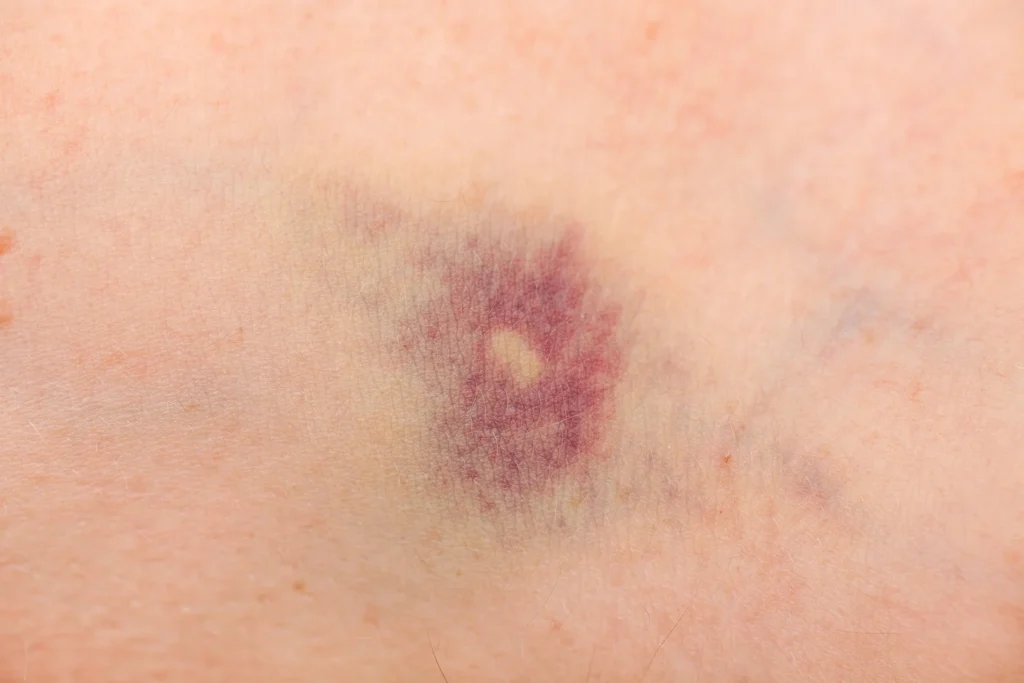
Normal bruising after filler injections may appear as small, localized areas of discoloration. Bruises can range from light purple to dark blue and may change colors as they heal, turning green and yellow before fading completely.
Cheek Filler Swelling Stages
Cheek filler swelling typically progresses through several stages:
- Immediate swelling: Occurs right after the procedure and can last up to 48 hours.
- Peak swelling: Usually happens within the first 24-48 hours post-treatment.
- Subside phase: Swelling starts to diminish around days 3-5.
- Resolution phase: Most swelling resolves within 2 weeks, revealing the final results.
Bruising Under the Eye After Cheek Filler
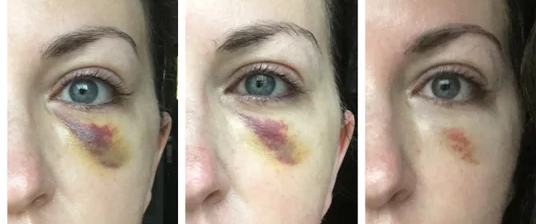
How To Cover Bruises From Filler Injections?
To cover bruises from filler injections:
- Use a high-quality concealer with yellow or peach undertones.
- Apply the concealer in thin layers, building up coverage as needed.
- Set the concealer with a translucent powder to ensure it stays in place throughout the day.
Conclusion
Bruising is a minor side effect, the risk of which accompanies any kind of injection, not just fillers. The good news is that, if you bruise, you can easily cover it up by applying a little bit of makeup to the area. After a few days, the bruising will subside and you will be as though nothing had ever happened – all you’ll have is a fuller, fresher face!
If you have any concerns about bruising, you can always get in touch with our board-certified experts at Syra Aesthetics for a detailed consultation before you are injected. However, just remember that just because bruising can happen, doesn’t mean that it will; furthermore, even if it does, it isn’t something to be worried about.
Frequently Asked Questions
How long does it take cheek fillers to settle?
Cheek fillers take about 2 weeks to settle fully. Initial results are visible immediately, but final results develop as swelling subsides.
Is it normal to bruise after cheek filler?
Yes, it is normal to experience some bruising after cheek fillers. Bruising usually resolves within a week.
Do cheek fillers lift your face?
Yes, cheek fillers can provide a subtle lift to the face. They enhance cheek volume, which can reduce the appearance of sagging.
Can I smile after cheek fillers?
Yes, you can smile after getting cheek filler treatment. However, you may feel slight discomfort or tightness initially.
How do you hide bruises from fillers?
Use a concealer with a yellow or peach undertone to hide bruises from filler treatments. Applying a cold compress can also help reduce swelling and discoloration.
How long do black eyes last?
Black eyes generally last about 1 to 2 weeks. The bruising will gradually fade through purple, green, and yellow shades.
How long does bruising last after lip filler?
Bruising after lip fillers typically last about 5 to 7 days. Applying ice and avoiding strenuous activities for keeping blood flow.
Does Botox cause bruising?
Botox can cause minor bruising at the injection sites. This is usually temporary and resolves within a few days.
How do blood vessels play a role in the bruising process after cheek fillers?
Small blood vessels play a role in the bruising process after cheek dermal fillers when they are punctured by the injection needle, causing blood to leak into the surrounding tissue. This leakage results in visible bruising and discoloration.

About The Author
Dr. Syra Hanif M.D.
Board Certified Primary Care Physician
Dr. Hanif is the Director of Aesthetic Medicine. She is a board-certified physician in Aesthetic Medicine who specializes in using non-surgical alternatives in order to enhance one's appearance through Botox and fillers.
Read More





